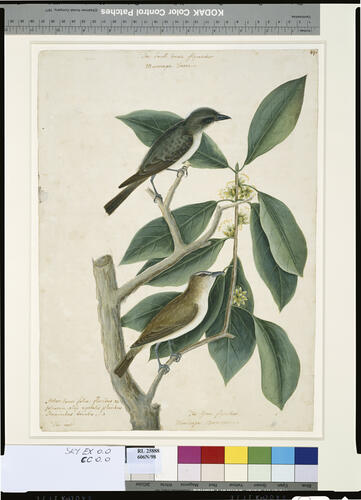The Little Brown Fly-catcher and the Red-ey'd Fly-catcher c.1722-26
37.2 x 26.5 cm (sheet of paper) | RCIN 925888
-
A watercolour of an eastern wood-pewee (above, Contopus virens (Linnaeus)) and an red-eyed vireo (below, Vireo olivaceus (Linnaeus)) on a branch of common sweetleaf (Symplocos tinctoria (L.) L'Her.). The drawing shows two birds perched on a branch which has dark green wide pointed leaves and small white flowers. The bird above has brown plumage and a white breast, profile right. Below a small bird with white breast and eyebrow. Inscribed in ink: (top centre)" 'The Small brown flycatcher. Muscicapa fusca'; (top right) '54'. Inscribed in ink at bottom: (bottom left): Arbor docuri folia floribus ex foliorum alijs a petalis pluribus Staminibus donatis - The root'; (bottom right) 'The Green flycather (sic.) Muscicapap Virescens'
Mark Catesby was born in Suffolk and was interested in natural history from an early age. In 1712, he travelled to the east coast of America with his sister Elizabeth, who had married a doctor who practised in Williamsburg, Virginia. Catesby spent seven years in Virginia collecting specimens and seeds for London buyers before returning to Britain. In London his drawings of birds and plants met with praise and a group of benefactors paid for his travel to Carolina in 1722. There, he made numerous drawings of the flora and fauna, working hard to ensure that his depictions were as helpful for an understanding of their subjects as possible. On his return to Britain, his drawings were reproduced in The Natural History of Carolina, Florida and the Bahama Islands, which appeared in a series of volumes between 1729 and 1747. The first volume was dedicated to Queen Caroline, the second to Augusta, Princess of Wales. The original drawings from the volumes, which had been in the possession of Catesby’s widow until her death, were purchased by George III from the London bookseller Thomas Cadell in 1768.
The watercolour was used as the basis for plate 54 in the first volume of the Natural History ('The little brown Fly-catcher' and 'The red-ey'd Fly-catcher').
For identification of the species depicted see James L. Reveal, 'Identification of the plants and animals illustrated by Mark Catesby for his Natural History of Carolina, Florida, and the Bahama Islands' in Phytoneuron 2013 and revised online version.Provenance
Thomas Cadell; from whom bought by George III, 1768
-
Creator(s)
Acquirer(s)
-
Measurements
37.2 x 26.5 cm (sheet of paper)
Other number(s)
RL 25888









